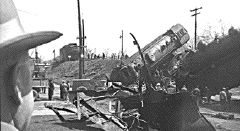
2 May 2006
Memories of Train Collision Still Haunt Engineer
| |

Above, Brian Sinclair holds a blown up version of his aerial view
photo of the crash, which occurred 50 years ago today. He sold copies of the shot for $10 each.
|
Cambridge - "It was a terrible sound of crushing steel on steel. A terrible, terrible
sound."
Retired engineer George Nutkins remembers what it was like to be aboard a train that made its last stop by crashing to the ground below
a collapsed overpass. The bridge crumbled when two trains collided - 50 years ago today - at the Water Street train bridge in Cambridge,
leaving two men dead and four others injured.
"They didn't think I was going to make it," Nutkins recalled.
Seconds before impact, Nutkins realized there wasn't enough time for him to escape the crash, so he sounded the steam engine's whistle
to warn pedestrians.
A few weeks after the two freights collided, an inquiry jury found that a combination of negligence and a lack of proper communication
were both contributing factors in the crash.
Nutkins was on Train 903's second engine when it and Train 5186 - dubbed then as the "extra" train that was not supposed to be
on the main line - collided atop the bridge.
"It was very fortunate that any of us made it at all," he said.
 Nutkins spent about two years recovering in Galt, London and Toronto hospitals with more than 20 fractures all over his body. His
injuries required he wear a body cast, as well as casts on his legs and arms. The injuries from the train crash have resulted in painful
arthritis for the 82-year-old.
Nutkins spent about two years recovering in Galt, London and Toronto hospitals with more than 20 fractures all over his body. His
injuries required he wear a body cast, as well as casts on his legs and arms. The injuries from the train crash have resulted in painful
arthritis for the 82-year-old.
"Heels, ankles, wrists," he said. "Pretty well anything that moves."
He gets around using a walker or cane and, on longer distances, he uses a motorized scooter.
After recovering from his extensive injuries, Nutkins went on to spend 42 years working for the Canadian Pacific Railway (CPR). For the
last eight years of his career he was superintendent of the London CPR division. He is now retired and lives in the veteran's wing at
Parkwood Hospital in London, Ont.
 During the Second World War, Nutkins was part of the air force Bomber Command.
During the Second World War, Nutkins was part of the air force Bomber Command.
At Parkwood, Nutkins said he used to spend his free time making watercolour paintings of landscapes and animals and even one of a train.
However, the loss of sight in his left eye has made painting a hobby of the past.
Railway operation, Nutkins said, is different today than it was 50 years ago.
"Safety has always been very important," he said.
With modern technology, he said there are more devices aboard trains to ensure a safer trek. Electronic sensors warn engineers when it
is safe to back up and when something is too close to train cars.
Fred Clare probably would have appreciated today's modern technology as he drove his car under the Water Street bridge just as it and
the two trains were crashing to the ground. Within inches of being crushed, Clare made it out unharmed.
John Clare, Fred's cousin, said Fred was driving a brand new Thunderbird at the time.
"I understand he had a good stiff drink before he went home," John said.
Fred died in March 1959.
On 3 May 1956 - the day after the crash - an 18-year-old student's curiosity didn't kill the cat, but rather
allowed him to take his most famous photograph when he crossed police tape at the scene of the crash.
"I looked at the situation and realized I would have needed a helicopter to get a good shot," said Brian Sinclair, former
owner of Brian's Foto Source on Dickson Street.
To get the "true perspective" of the crash, Sinclair said he pre-set the focus on his camera and then climbed up
the abutment - the lateral supporting structure of the bridge - where he peered over and snapped the photo.
Police saw him and yelled at him to get down.
"I only had time to get one (photograph)," he said.
A Toronto reporter, taking photos of the same crash, was jailed for interfering with police work when he ducked under a barricade to get
a better shot.
Sinclair went on to work at the Galt Evening Reporter for three years, then taught evening photography classes at Conestoga College for
11 years, and later owned a camera shop for 25 years.
Today, he spends his time playing acoustic instruments in a local band and is also a member of the Cambridge Splinters, a Morris dancing
group. Although it has been 50 years since the crash, Sinclair said it still feels strange when he passes underneath the Water Street
bridge.
The crash was cleaned up within days of the tragic evening and the sounds of clashing steel are long gone. But for some, the memories
of that night will live on forever.
|